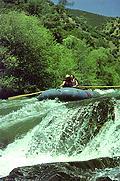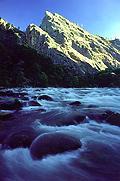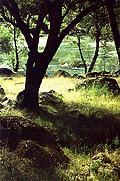| |
| Stretch: |
Camp-9 Powerhouse to Parrott's Ferry Bridge |
| Difficulty: |
Class III with one IV (much harder above 8000 cfs) |
| Distance: |
9 miles, 1 day |
| Flows: |
rafts and kayaks 700 - 2000 cfs |
| Gauge: |
inflow to New Melones Reservoir
(NML) |
| Gradient: |
30 fpm average, pool and drop, steeper at beginning |
| Put-in: |
Powerhouse at end of Camp 9 road, 1070' |
| Take-out: |
old Parrott's Ferry Bridge, 800' |
| Shuttle: |
20 miles (1 hour) one-way |
| Maps: |
USFS Stanislaus NF, AAA Lake Tahoe Region,
Topo
|
| Season: |
summer and fall of drought years, from hydropower release |
| Agency: |
mostly BLM, some private |
| Notes: |
© 1998 Bill Tuthill,
CreeksYahoo,
thanks to Craig Schwyn and Greg Schmidt |
Formerly called the upper Stanislaus, now the drowned Camp-9 run,
at one time this was acknowledged as the best intermediate run in California.
People who knew the river before it was inundated by New Melones reservoir
might feel overly depressed seeing it again, but for the rest of us,
this run is well worth doing after a string of drought years.
Many of the class II and class III rapids are totally unique,
and beautiful limestone cliffs and forested hillsides are visible
above the reservoir's bathtub ring.
Although the length is only 9 miles,
it goes slowly, so allocate an entire day.
Camping is possible on the reservoir at Glory Hole (seldom crowded)
and at certain undeveloped spots along the road to put-in.
However note that this river is only a few hours away from population centers.
The Stanislaus canyon is one of the few limestone areas in California,
which implies that there are many caves around.
A tourist visit to nearby Moaning Caves makes an interesting side-trip.
- mile
- 0
- Put in downstream from the powerhouse and wooden check dam, probably on
the right bank. An old bridge across the river offers a bit of shade.
On the hillside above is an old flume that brought water to miners.
The trip starts with a long pool, giving you time to warm up.
- .4
- Cadillac Charlie, class II, a left turn against the right bank.
- .5
- Rock Garden, class II+, a long slalom among rocks and boulders ending
with some big waves.
- .8
- Big Dog, class IV
This rapid was created by bridge construction debris, and did not look
the same in the old days. Originally named because rowboats had to
pull like a “big dog” to avoid shore. Later (re)named
after a brand of shorts that got stuck on a snag, pulling a raft guide
away from her boat and crew, who ran the rapid successfully without
her. You should scout this from the bridge when you do the shuttle.
This steep rapid ends with several big holes, and sharp entrapment
rocks might lurk on the right.
- .9
- Suspension Bridge, class II+, contains some diagonal waves that can
easily flip small boats if you approach them sideways. Angle right.
- 1.1
- Death Rock, class III
Kind of like the Rock Garden, but bigger. The rapid is named
after a large undercut boulder on the bottom right. Some routes
avoid this undercut. In the olden days when this rapid was named,
nobody actually died at Death Rock. During the drought of the 1980s
however, a private raft flipped running Big Dog above 5000 cfs, and
one rafter (who had refused to wear a wetsuit) was swept downstream
(last seen with his feet upstream, probably owing to hypothermia)
.3 mile into the undercut, where he drowned.
- Formerly, at low water rafts had to hug the left wall, pull hard
right and shoot thru a narrow slot (boats had to be nearly 90°
to the current or they could wrap), then float towards the center
and move left just above Death Rock. At high water a simpler route
on the right, thru a nice hole, became available.
- 1.3
- Devil's Staircase, class II+, a series of sharp drops among rocks
in a small channel. Some of the narrow chutes, especially ones too
narrow for a raft, are lots of fun in a kayak. A rock was located to
the left of the photo (river right) and rafts had to drop down between
that and the rock shown in the foreground of the photo.
-

|
Old-style raft in Staircase with shuttle road high above
Photograph scanned from Tim Palmer's excellent book about
the New Melones saga and the founding of Friends of the River,
Stanislaus, The Struggle for a River,
published by the University of California Press.
Photograph by Tim Palmer.
|
- 1.5
- Bailey Falls, class III
When flows are low, the boulder bar entrance is very skinny and
route finding becomes difficult; try the right. Below the boulder
bar drop, the current funnels against bedrock into a large hole.
Stay away from the right wall, which could bruise your elbow, and
which in the olden days caused the demise of many a fiberglass kayak.
- 1.7
- Widowmaker, class III
Two large rocks diagonally guard the right. The most fun route is
between the rocks, behind the first and in front of the second.
A rockier but more straightforward route is available on far left,
except at very low flows. Many kayaks flip here.
- 2.1
- Rose Creek enters on the left, in the midst of an extended and
enjoyable class II slalom among big rocks. Good lunch stop and
side hike, although in the old days, crowds here were so huge
that everybody agreed to lunch elsewhere. Good rapids continue
immediately below.
- 2.5
- Wool Hollow creek enters on the right. The limestone peak upstream
is one of the most scenic along the Stanislaus. In the old days,
blasting operations at a nearby quarry often petrified boaters.
There was a fine rope swing at the base of the cliff.
- 2.6
- Mother Rapid, class II, a boulder bar with rock on the left below.
-

|
Evening light on the limestone peak above Mother Rapid
Photograph scanned from Tim Palmer's excellent book about
the New Melones saga and the founding of Friends of the River,
Stanislaus, The Struggle for a River,
published by the University of California Press.
Photograph by Tim Palmer.
|
- 2.9
- Razorback Rapid, class II, against a cliff on the left of upturned
limestone containing marble veins (actually silicic sponges) that
often punctured incorrectly maneuvered rafts.
- 3.5
- Deadman's, class II, yet another stupid name, a long boulder bar
leading towards, but at low flows not into, a tall cliff on the right.
- 5
- Crystal Cave high on the right bank makes an interesting side-hike.
Be sure to take at least two flashlights into the cave, in case one
runs out of batteries. Several narrow passages lead to a large
central chamber. The cave was nicer before reservoir siltation.
- 5.1
- Abon's Cop Rock, class II
- 5.5
- South Fork of the Stanislaus enters on the left. This river trip
becomes worthwhile when the reservoir recedes to this level, about
900' elevation. In the miles ahead, marble quarry roads become
visible on the left bank.
- 6.5
- Boat Tenderizer, AKA Deep Throat, class II
- 6.9
- Sierra Club Rapid, class II, named because Sierra Club rafters often
wrapped on an undercut fin rock in the middle of the left channel.
Usually there were a couple boats wrapped on top of each other until
flows receded in summertime. This was the epitome of a wrap rock.
- 7.3
- Wino's Swim, class II, formerly a good place to practice swimming
with feet up.
- 8.1
- Chinese Dog Leg, class II+ on the correct route, class III+ otherwise.
This is one of the most unusual rapids anywhere, partly because it
looks totally impossible until you discover the best route. Enter
right of center and move all the way left, make a sharp right turn,
and choose any exit route. The best ride was on a big wave train
along the left bank. This rapid might have been named after Chinese
gold miners who worked the area. A distance below this rapid was
Manhattan Beach on the left, a hangout for locals where slow moving
water had deposited a white sand beach.
- 8.7
- Chicken Falls, class III on the left (over the falls), class II on
the right (chicken route). My informants warn me,
“Don't run Chicken Falls naked on a log at 10000 cfs,”
as if they had actually tried it. This falls is followed by
another rapid just before take-out, where swiftwater continues for a distance.
-

|
Rapids and beautiful oak forest above Parrott's Ferry
Photograph scanned from Tim Palmer's excellent book about
the New Melones saga and the founding of Friends of the River,
Stanislaus, The Struggle for a River,
published by the University of California Press.
Photograph by Tim Palmer.
|
- 9
- Parrott's Ferry Bridge. Take out on the left bank below, or on the
bridge if the reservoir is high.
The South Fork of the Stanislaus is runnable from Strawberry down to the
confluence. According to Chuck Stanley, the section from the highway 108
bridge in Strawberry to Lyons reservoir is 11.7 miles of class IV to V
with brush. According to Lars Holbek, the section from Italian Bar
to the confluence is 5.8 miles of class V with one probable portage.
Chris Shackleton sent this trip report of the lower section:
We spent two unscheduled nights on the South Fork Stanislaus,
without any food, dry clothing or anything except one space blanket,
iodine tablets, and a lighter. We were expecting a 3-hour trip and
it took 50!! I'd love to say we were fishin' and swappin' yarns and
having us a grand 'ol time, but the fact of the matter is we were famished,
weak as kittens, and covered in poison oak by the time a gold-hunting
boat crew happened by and gave us a ride across New Melones reservoir.
A most educational experience ... ever since then I've been acutely aware
of subtleties like time of year, time of day, distance to take-out.
The reason we went so slowly was that this was the first decent water year
after many drought years, and after the first few miles, many trees had
grown into the river bed. Some, naturally, had fallen down. The river
was therefore fully into the trees, and there were strainers, so while
it wasn't high in an absolutely sense, it was high and potentially dangerous
considering the trees. I was a relatively new boater and didn't have the
skills to boat blindly downstream under those conditions, so we had to
basically scout every inch of the way. Because there were strainers and
other obstacles we ended up dragging our boats a great deal: we would
scout, return to the boats, then drag the boats downstream, covering the
same ground three times. Eventually we left the boats and hiked the rest
of the way. The run itself wasn't therefore inherently a poison oak fest,
we just made it into one by scouting and dragging our boats through it.
|
|
Creeks Navigation
Home
Recommended Runs
Map of Rivers
Alphabetic Index
Alphabetic Table
Text Search
Sponsored Links
|


